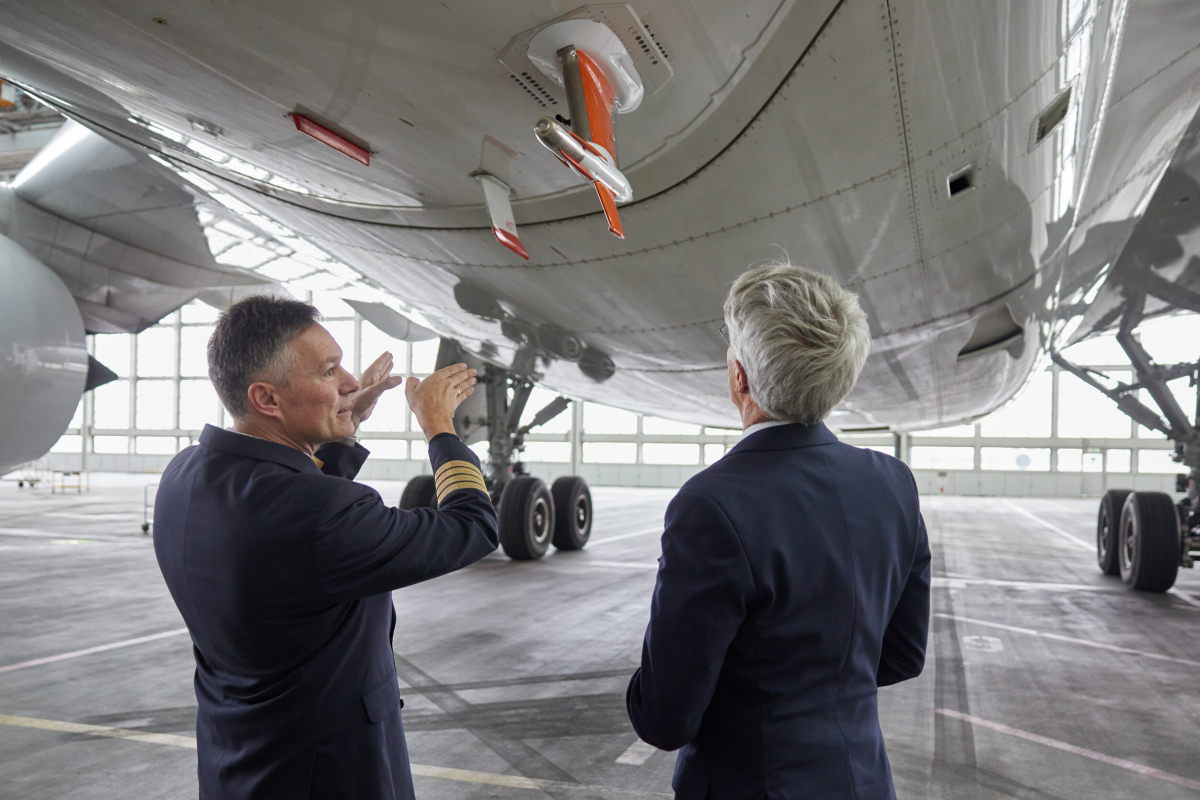The Lufthansa Group and the Karlsruhe Institute of Technology are turning the Lufthansa Airbus A350-900 "Erfurt" into a flying research laboratory. The measuring probe will record more than 100 different trace gases, aerosols and cloud parameters. First flight in 2024.
A measurement probe system attached to the lower fuselage of Lufthansa's Airbus A350
The Lufthansa Group and the Karlsruhe Institute of Technology (KIT) are currently transforming Lufthansa's Airbus A350-900 "Erfurt" (registration number D-AIXJ) into a flying research laboratory. For the first time, experts from the Lufthansa Group have attached the measurement probe system developed especially for the project to the lower fuselage of the A350 and have successfully tested it in flight. Lufthansa pilots conducted a coordinated flight program with the certification authorities in southern German airspace. The measurement system currently being tested on the aircraft is the most complex of its kind and, in addition to the air intake function, includes sensors for high-frequency, high-accuracy pressure and temperature measurement. Starting in 2024, the Airbus will collect comprehensive climate data during scheduled passenger flights for the European research infrastructure IAGOS-CARIBIC.
The IAGOS-CARIBIC project began in 2004
The conversion of the A350 "Erfurt" into a research laboratory was preceded by a planning and development phase that lasted several years. In addition to the Lufthansa Group and KIT, six other companies (Lufthansa Technik, Airbus, Safran, enviscope, Dynatec and ACC COLUMBIA Jet Service) are involved in the IAGOS-CARIBIC project. KIT is also the coordinator of a scientific consortium of twelve research institutions in Europe and the USA, whose complex measuring instruments will explore the atmosphere in the flying research laboratory. IAGOS stands for "In-service Aircraft for a Global Observing System" and CARIBIC for "Civil Aircraft for the Regular Investigation of the atmosphere Based on an Instrument Container". This is not the first time that Lufthansa has turned one of its commercial aircraft into a flying research laboratory. From December 2004 to 2020, a Lufthansa Airbus A340-600 (registration number D-AIHE) has already flown about 500 measurement flights in the service of climate and atmospheric research within the framework of the CARIBIC project.
First flight in 2024 for the flying laboratory
Over the next few months, a measurement laboratory weighing about two tons and specially developed for the project will be set up. About 20 measuring instruments will be installed in the laboratory, which will then be loaded into the cargo bay as a freight container and connected to the measuring system on the outer fuselage of the aircraft. Next year, this high-tech laboratory will take off for the first time and collect climate data on selected flights in Lufthansa's scheduled operations around the world. The laboratory continuously records more than 100 different parameters of trace gases, aerosols and clouds from the ground to the tropopause region at an altitude of between nine and 13 kilometers. What makes it special: Parameters important to climate can be recorded at this altitude with significantly higher accuracy and temporal resolution on board the aircraft than would be possible with ground-based or satellite-based measurement systems.
To record more than 100 different parameters related to trace gases, aerosols and clouds from the ground to the tropopause region
The laboratory continuously records more than 100 different parameters related to trace gases, aerosols and clouds from the ground to the tropopause region, at an altitude of between nine and 13 kilometers. What makes it special: Climate-relevant parameters can be recorded at this altitude with much higher accuracy and temporal resolution on board the aircraft than would be possible with ground or satellite-based measurement systems. "IAGOS-CARIBC helps fill a critical gap in our understanding of the climate system. With high-precision measurements of many parameters, we can understand what atmospheric processes are changing and how in the context of climate change, in an upper-air region where most of the atmosphere's radiation budget, i.e. the greenhouse effect, is generated and modified. In this way, we can identify process-specific errors and their causes in climate models and subsequently improve their predictive capabilities," says Andreas Zahn of KIT and coordinator of IAGOS-CARIBIC.

